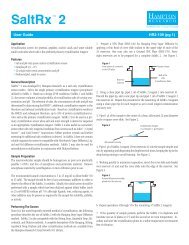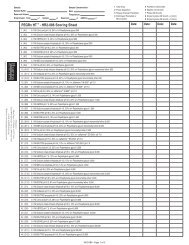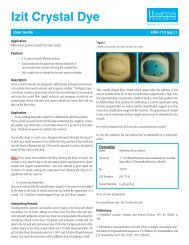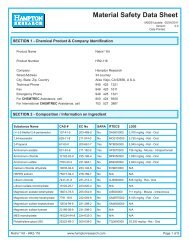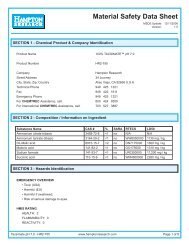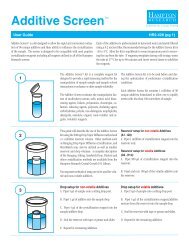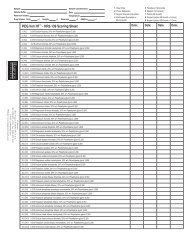MSDS for HR2-583 - Hampton Research
MSDS for HR2-583 - Hampton Research
MSDS for HR2-583 - Hampton Research
- No tags were found...
You also want an ePaper? Increase the reach of your titles
YUMPU automatically turns print PDFs into web optimized ePapers that Google loves.
(CONTINUED) SECTION 3 - Hazards IdentificationNFPA RATINGHEALTH HAZARD: 3FLAMMABILITY: 0REACTIVITY HAZARD: 2SPECIAL HAZARD: WPOTENTIAL HEALTH EFFECTS• INHALATION: May be harmful if inhaled. Material is extremely destructive to the tissue of the mucousmembranes and upper respiratory tract.• SKIN:May be harmful if absorbed through skin. May cause skin irritation.• SKIN CONTACT: Causes skin burns.• EYES:Causes eye burns.• INGESTION: May be harmful if swallowed. Causes burns.For additional in<strong>for</strong>mation on toxicity, please refer to SECTION 11.SECTION 4 - First Aid MeasuresGENERAL ADVICE• Consult a physician.• Show this safety data sheet to the doctor in attendance.ORAL EXPOSURE• Do NOT induce vomiting. Never give anything by mouth to an unconscious person.• If swallowed, wash out mouth with water provided the person is conscious.• Consult a physician.INHALATION EXPOSURE• If inhaled, remove to fresh air. If not breathing give artifi cial respiration.• If breathing is diffi cult, GIVE OXYGEN.• Consult a physician.DERMAL EXPOSURE• Take off contaminated clothing and shoes immediately.• Flush with copious amounts of soap and water <strong>for</strong> at least 15 minutes.• Consult a physician.EYE EXPOSURE• In case of contact with eyes, fl ush with copious amounts of water <strong>for</strong> at least 15 minutes.• Assure adequate fl ushing by separating the eyelids with fi ngers.• Continue rinsing eyes during transport to hospital.• Consult a physician.1.0 M Sodium hydroxide - <strong>HR2</strong>-<strong>583</strong> www.hamptonresearch.com Page 2 of 8
SECTION 5 - Fire Fighting MeasuresFLASH POINT• N/AAUTOIGNITION TEMPERATURE• N/AEXTINGUISHING MEDIA• Suitable: Use extinguishing measures that are appropriate to local circumstances and the surroundingenvironment.FIREFIGHTING• Protective Equipment: Wear self-contained breathing apparatus and protective clothing to prevent contactwith skin and eyes.FURTHER INFORMATION• The product itself does not burn.SECTION 6 - Accidental Release MeasuresPROCEDURE(S) OF PERSONAL PRECAUTIONS• Use personal protective equipment. Wear self-contained breathing apparatus, rubber boots, and heavyrubber gloves.• Ensure adequate ventilation. Avoid dust <strong>for</strong>mation. Avoid breathing dust.• Evacuate personnel to safe areas.ENVIRONMENTAL PRECAUTIONS• Do not let product enter drains.METHODS FOR CLEANING UP• Pick up and arrange disposal without creating dust. Sweep up and shovel.• Keep in suitable, closed containers <strong>for</strong> disposal.• Ventilate area and wash spill site after material pickup is complete.SECTION 7 - Handling & StorageHANDLING• User Exposure: Avoid <strong>for</strong>mation of dust and aerosols.Provide appropriate exhaust ventilation at places where dust is <strong>for</strong>med.STORAGE• Suitable: Keep container tightly closed.1.0 M Sodium hydroxide - <strong>HR2</strong>-<strong>583</strong> www.hamptonresearch.com Page 3 of 8
SECTION 8 - Exposure Controls / PPECOMPONENTS WITH WORKPLACE CONTROL PARAMETERSComponents CAS # Value Control Update BasisParametersSodium hydroxide 1310-73-2 CEIL 2 mg/m3 1994-09-01 US. American Conference andIndustrial Hygienists Threshold LimitValues <strong>for</strong> Chemical Substances in theWork Environment; Annual Reports <strong>for</strong>the Year 2004: Committees onThreshold Limit Values (TLVs) andBiological Exposure Indices (BEIs)CEIL 2 mg/m3 1989-03-01 US. Department of Labor -Occupational Safety and HealthAdministration (OSHA)Permissible Exposure Limits (PEL) 29CFR 1910.1000 Air ContaminantsTWA 2 mg/m3 1993-06-30 US. Department of Labor -Occupational Safety and HealthAdministration (OSHA)Permissible Exposure Limits (PEL) 29CFR 1910.1000 Air Contaminants.PERSONAL PROTECTIVE EQUIPMENT• Respiratory: Where risk assessment shows air-purifying respirators are appropriate use a full-face particlerespirator type N100 (US) or type P3 (EN 143) respirator cartridges as a backup to engineering controls. If therespirator is the sole means of protection, use a full-face supplied air respirator. Use respirators andcomponents tested and approved under appropriate government standards such as NIOSH (US) or CEN(EU).• Hand: Handle with protective gloves.• Eye: Chemical safety goggles.• Skin and body protection: Choose protection according to the amount and concentration of the dangeroussubstance at the work place.GENERAL HYGIENE MEASURES• Wash contaminated clothing be<strong>for</strong>e reuse.• Handle in accordance with good industrial hygiene and safety practice.• Wash hands be<strong>for</strong>e breaks and at the end of the workday.SECTION 9 - Physical / Chemical PropertiesAPPEARANCE COLOR: WhitePHYSICAL STATE: PelletsPROPERTY VALUE AT TEMPERATURE OR PRESSUREMolecular Weight 40.001.0 M Sodium hydroxide - <strong>HR2</strong>-<strong>583</strong> www.hamptonresearch.com Page 4 of 8
(CONTINUED) SECTION 9 - Physical / Chemical PropertiesPROPERTY VALUE AT TEMPERATURE OR PRESSUREpHN/ABP / BP Range 318 ° C (604 ° F)MP / MP Range 1,390 ° C (2,534 ° F)Flash PointN/AIgnition TemperatureN/ALower Explosion LimitN/AUpper Explosion LimitN/AVapor Pressure < 24.00 hPa (< 18.00 mmHg) at 20 ° C (68 ° F)4.00 hPa (3.00 mmHg) at 37 ° C (99 ° F)Density2.1300 g/cm3Water SolubilityN/AN/A = NOT AVAILABLESECTION 10 - Stability & ReactivitySTABILITY• Stable under recommended storage conditions.MATERIAL TO AVOID• Materials to Avoid: Strong oxidizing agents, Strong acids, Organic materialsCONDITIONS TO AVOID• N/AHAZARDOUS DECOMPOSITION PRODUCTS• Formed under Fire Conditions - Sodium/sodium oxidesHAZARDOUS POLYMERIZATION• Will not occur.SECTION 11 - Toxicological In<strong>for</strong>mationACUTE TOXICITY• N/AIRRITATION AND CORROSION• Skin - rabbit - Severe skin irritation - 24 h• Eyes - rabbit - Severe eye irritation - 24 h1.0 M Sodium hydroxide - <strong>HR2</strong>-<strong>583</strong> www.hamptonresearch.com Page 5 of 8
(CONTINUED) SECTION 11 - Toxicological In<strong>for</strong>mationSENSATION• N/ACHRONIC EXPOSURE• IARC:No component of this product present at levels greater than or equal to 0.1% is identifi edas probable, possible, or confi rmed human carcinogen by IARC.• ACGIH: No component of this product present at levels greater than or equal to 0.1% is identifi edas a carcinogen or potential carcinogen by ACGIH.• NTP:No component of this product present at levels greater than or equal to 0.1% is identifi edas a known or anticipated carcinogen by NTP.• OSHA: No component of this product present at levels greater than or equal to 0.1% is identifi edas a carcinogen or potential carcinogen by OSHA.SIGNS & SYMPTOMS OF EXPOSURE• Spasm, infl ammation and edema of the larynx, spasm, infl ammation and edema of the bronchi, pneumonitis,pulmonary edema, burning sensation, cough, wheezing, laryngitis, shortness of breath, headache, nausea,vomiting. Material is extremely destructive to tissue of the mucous membranes and upper respiratory tract,eyes, and skin.POTENTIAL HEALTH EFFECTS• INHALATION: May be harmful if inhaled. Material is extremely destructive to the tissue of the mucousmembranes and upper respiratory tract.• SKIN:May be harmful if absorbed through skin. May cause skin irritation.• SKIN CONTACT: Causes skin burns.• EYES:Causes eye burns.• INGESTION: May be harmful if swallowed. Causes burns.SECTION 12 - Ecological In<strong>for</strong>mationELIMINATION INFORMATION (PERSISTENCE AND DEGRADABILITY)• N/AECOTOXICITY EFFECTS• Toxicity to fi sh• Toxicity to daphniaand other aquaticinvertebratesLC50 - Gambusia affi nis (mosquito fi sh) - 125 mg/l - 96 hImmobilization EC50 - Daphnia - 40.38 mg/l - 48 hFURTHER INFORMATION ON ECOLOGY• No data available.1.0 M Sodium hydroxide - <strong>HR2</strong>-<strong>583</strong> www.hamptonresearch.com Page 6 of 8
SECTION 13 - Disposal ConsiderationsAPPROPRIATE METHOD OF DISPOSAL OF SUBSTANCE OR PREPARATION• Contact a licensed professional waste disposal service to dispose of this material.• Dissolve or mix the material with a combustible solvent and burn in a chemical incinerator equipped with anafter burner and a scrubber.• Observe all federal, state, and local environmental regulations.CONTAMINATED PACKAGING• Dispose of as unused product.SECTION 14 - Transportation In<strong>for</strong>mationDOT (US)• Proper Shipping Name: Sodium hydroxide, solidUN#: 1823Class: 8Packing Group: IIIMDG• Proper Shipping Name: Sodium hydroxide, solidUN#: 1823Class: 8Packing Group: IIEMS-No: F-A, S-BIATA• Proper Shipping Name: Sodium hydroxide, solidIATA UN Number: 1823Class: 8Packing Group: IISECTION 15 - Regulatory In<strong>for</strong>mationOSHA HAZARDS• CorrosiveTSCA STATUS• On TSCA inventoryDSL STATUS• All components of this product are on the Canadian DSL list.SARA 302 COMPONENTS• SARA 302: No chemicals in this material are subject to the reporting requirements of SARA Title III, Section302.1.0 M Sodium hydroxide - <strong>HR2</strong>-<strong>583</strong> www.hamptonresearch.com Page 7 of 8
(CONTINUED) SECTION 15 - Regulatory In<strong>for</strong>mationSARA 313 COMPONENTS• SARA 313: This material does not contain any chemical components with known CAS numbers that exceedthe threshold (De Minimis) reporting levels established by SARA Title III, Section 313.SARA 311/312 HAZARDS• Acute Health HazardMASSACHUSETTS RIGHT TO KNOW COMPONENTS• Sodium hydroxide: CAS-No: 1310-73-2 Revision Date: 1989-12-01PENNSYLVANIA RIGHT TO KNOW COMPONENTS• Sodium hydroxide: CAS-No: 1310-73-2 Revision Date: 1989-12-01NEW JERSEY RIGHT TO KNOW COMPONENTS• Sodium hydroxide: CAS-No: 1310-73-2 Revision Date: 1989-12-01CALIFORNIA PROP. 65 COMPONENTS• This product does not contain any chemicals known to State of Cali<strong>for</strong>nia to cause cancer, birth, or any otherreproductive defects.ADDITIONAL CLASSIFICATION• Symbol of Danger: C• Indication of Danger: Corrosive• R: 35• Risk Statements: Causes severe burns.• S: 26 37/39 45• Safety Statements: In case of contact with eyes, rinse immediately with water and seek medical advice.Wear suitable gloves and eye/face protection. In case of accident or if you feel unwell, seek medical adviceimmediately (show the label where possible).SECTION 16 - Other In<strong>for</strong>mationDISCLAIMER• For R&D use only. Not <strong>for</strong> drug, household, or other use.WARRANTY• The above in<strong>for</strong>mation is believed to be correct but does no purport to be all inclusive and shall be used onlyas a guide. The in<strong>for</strong>mation in this document is based on the present state of our knowledge and is applicableto the product with regard to appropriate safety precautions. It does not represent any guarantee of the propertiesof this product. <strong>Hampton</strong> <strong>Research</strong> Corp., shall not be held liable <strong>for</strong> any damage resulting from handlingor from contact with the above product. See reverse side of invoice or packing slip <strong>for</strong> additional terms andconditions of sale.• License granted to make unlimited paper copies <strong>for</strong> internal use only.© 2008 <strong>Hampton</strong> <strong>Research</strong> Corp.1.0 M Sodium hydroxide - <strong>HR2</strong>-<strong>583</strong> www.hamptonresearch.com Page 8 of 8



